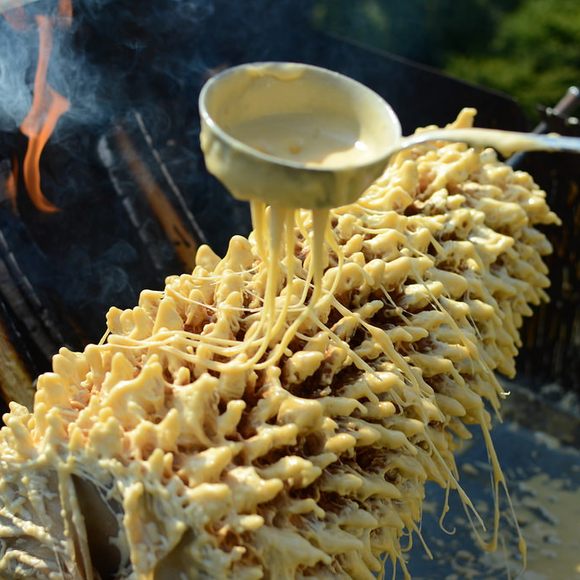Most cakes are created in about the same way: You mix a batter, pour it into a pan, and bake it in an oven. Spit cakes, in dramatic contrast, are cooked by flinging batter onto a rotating dowel over an open flame.
Variations of spit cakes are popular across Europe. In Hungary, Slovakia, and the Czechia, spit cakes tend to be tubular; German baumkuchen looks like donuts stacked one on top of the other.
One of the most dramatic spit cakes, though, is the Lithuanian version, sakotis. In the final stages of the cooking process, bakers increase the speed at which the spit rotates, which causes spikes to form as batter is flung towards the fire. The result is a cake that resembles a Christmas tree.
Making sakotis can easily take five hours. Bakers ladle batter along the spit in regular stages, and the skill comes from knowing just how much batter to add—and just how long to wait—so all the batter stays on the cake. By piling more batter in the middle, and then cutting the final product in two, bakers can achieve a tree-like appearance. For fancy affairs, like weddings, they may decorate enormous sakotis, which stand taller than some guests, with sugary flowers, nuts, and drizzles of chocolate.
You can buy spit cake in single-serving sizes. But given the labor-intensive baking process, they’re almost always made large and then cut up. In 2015, to inaugurate a tree cake museum, the company Romnesa organized the baking of a record-holding, 12-foot-long spit cake.
Where to Try It
-
Racine Bakery
6216 South Archer Avenue, Chicago, 60638, USAThis Lithuanian and Polish bakery in Chicago is a good place to try spit cake in the United States.
Written By
 Sarah Laskow
Sarah Laskow














